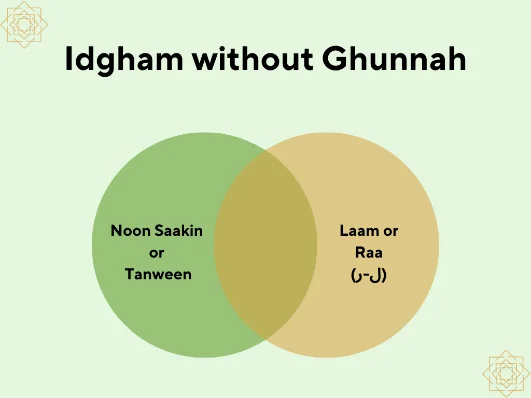Rules of Ghunnah in Tajweed, the art of reciting the Quran with proper pronunciation and articulation, involves mastering various rules that enhance the beauty and precision of Quranic recitation. Among these rules, Ghunnah is essential, as it governs the nasal sound in Arabic recitation. This blog provides a detailed overview of the rules of Rules of Ghunnah in Tajweed, followed by a FAQ section to address common questions.
What is Ghunnah in Tajweed?
Master the Rules of Ghunnah in Tajweed refers to a nasal sound produced during Quranic recitation. It occurs with letters that require a nasalization effect, and it is sustained to maintain clarity and flow in pronunciation. Ghunnah is typically produced from the nasal passage, without the use of the tongue or lips, and it is a natural part of the sound produced with certain letters in the Quran.

In Arabic, Master the Rules of Ghunnah in Tajweed is mainly associated with the letters Meem (م) and Noon (ن). These letters, when followed by specific letters or symbols, lead to a nasalized sound. Proper understanding and application of Ghunnah improve the reciter’s fluency and adherence to the rules of Tajweed.
Master the Rules of Ghunnah in Tajweed
Master the Rules of Ghunnah in Tajweed is essential for reciting the Quran correctly. Ghunnah refers to a nasal sound that occurs during the pronunciation of certain letters and is characterized by prolonged nasalization. Here’s an overview of the key rules:
1- Idgham with Ghunnah:
- When Noon Saakinah (نْ) or Tanween (ً ٍ ٌ) is followed by the letters ي ,م ,ن, or و, Ghunnah is required.
- This rule emphasizes merging the sounds of Noon Saakinah or Tanween with the following letter while maintaining a nasal sound.
- Example: “مِنْ وَلِيٍّ حَمِيد” (min waliyyin hameed).
2- Ikhfaa with Ghunnah:
- This occurs when Noon Saakinah or Tanween is followed by any letter other than the six letters of Idh-haar (أ ,ع ,غ ,ح ,خ ,ه).
- Ikhfaa with Ghunnah requires hiding the sound of Noon or Tanween but maintaining a nasal sound for a set duration.
- Example: “مَن قَالَ” (man qaala).
3- Idgham without Ghunnah:
- This happens when Noon Saakinah or Tanween is followed by ل (Lam) or ر (Raa), resulting in a complete merger without a nasal sound.
- Example: “مَن رَّبِّكُم” (man rabbikum).
4- Iqlaab:
- This rule applies when Noon Saakinah or Tanween is followed by ب (Baa). Here, the Noon sound changes to a Meem sound with a prolonged Ghunnah.
- Example: “أَنبَاؤُكُمْ” (anba’ukum).
5- Meem Saakinah with Ghunnah:
- When a Meem Saakinah (مْ) is followed by another Meem (م), Ghunnah is applied by merging the two Meem sounds with a nasalized prolongation.
- Example: “كَم مِّنْ فِئَةٍ” (kam min fi’atin).
Why is Ghunnah Important in Tajweed?

- Enhances Recitation Quality: Proper application of Ghunnah improves the melodious and rhythmic quality of the recitation, making it pleasing to the listener and closer to the traditional style.
- Preserves the Meaning: Correct Tajweed preserves the original meanings of Quranic words, as incorrect pronunciation can sometimes alter meanings.
- Strengthens Connection: Practicing Ghunnah with care reflects respect for the Quran and strengthens one’s connection with the divine words.
Rules of Ghunnah in tajweed
The rules of Master the Rules of Ghunnah in Tajweed refer to the nasal sound produced when pronouncing certain letters, specifically when they are followed by certain conditions. Master the Rules of Ghunnah in Tajweed is an important aspect of Arabic phonetics and is often found in the recitation of the Qur’an. Here are the key rules regarding Ghunnah:
- Letters of Ghunnah: The letters that specifically produce Ghunnah are the nasal letters: م (Mīm) and ن (Nūn). Ghunnah is also applied when these letters occur in specific conditions, such as:
- Nunnation (Tanween): When a word ends with -an, -in, or -un, a Ghunnah sound is produced.
- Nūn Sākīn (ن): When ن is in a state of Sākīn (not having a vowel), followed by any of the letters of Idghām or any letter that causes Ghunnah.
- Types of Ghunnah:
- Ghunnah Mīm (غنة ميم): When the letter م is pronounced, the sound comes from the nose.
- Ghunnah Nūn (غنة نون): This is more pronounced and emphasized, especially in the case of Tanween or Nūn Sākīn.
- Duration: The duration of Ghunnah is typically two counts (or beats) in proper Tajweed. It is important to maintain this duration without rushing the sound.
- Idghām with Ghunnah: In cases where Nūn Sākīn is followed by one of the letters of Idghām (ي, ن, م, و, ل), the Ghunnah is pronounced as a nasal sound without a pause, and the letter following Nūn is blended smoothly with the nasal sound.
- Exceptions: If ن or م is followed by certain letters (for example, when it precedes a letter where the rules of Ikhfā or Idghām are applied), the Ghunnah may change in application or duration.
When is Ghunnah Applied?
Master the Rules of Ghunnah in Tajweed sound is applied under certain conditions, generally when a “Meem” or “Noon” letter has a Shaddah ( ) or is followed by specific letters that cause nasalization. Here are the primary rules:
-
1. Ghunnah in Noon Sakinah and Tanween
When Noon Sakinah (نْ) or Tanween appears before specific letters, Ghunnah must be applied. These letters include:
- Yarmaloon: The letters (ي، ر، م، ل، و، ن)
- If Noon Sakinah or Tanween is followed by these letters, Ghunnah is applied.
-
2. Ghunnah in Meem Sakinah
- Meem Sakinah (مْ) also requires Ghunnah under specific conditions, particularly when it precedes a “Meem” or “Baa” letter. This rule ensures that the nasal sound resonates effectively.
-
3. Idgham with Ghunnah
- Idgham with Ghunnah happens when the Noon Sakinah or Tanween appears before the letters Ya, Noon, Meem, or Waw. In this situation, the sounds are merged with Ghunnah applied for two counts.
-
4. Ikhfa with Ghunnah
- Ikhfa occurs when Noon Sakinah or Tanween precedes any letter except for those requiring Idgham, Izhar, or Iqlab. In this scenario, the sound is hidden with Ghunnah applied for two counts.
Examples of Ghunnah in the Quran
-
- Noon Sakinah with Tanween:
-
Surah Al-Baqarah (2:2):
-
- Noon Sakinah with Tanween:
-
ذَٰلِكَ الْكِتَابُ ۖ لَا رَيْبَ فِيهِ ۛ هُدًى لِّلْمُتَّقِينَ
-
-
- The word “مُتَّقِينَ” has a Ghunnah sound with the Tanween (نٍ).
-
- Noon Sakinah followed by Idgham:
-
Surah Al-Baqarah (2:3):
-
الَّذِينَ يُؤْمِنُونَ بِالْغَيْبِ وَيُقِيمُونَ الصَّلَاةَ وَمِمَّا رَزَقْنَاهُمْ يُنفِقُونَ
-
In “مِمَّا”, the ن is assimilated into the م, creating a Ghunnah.
-
-
- Noon Sakinah followed by Ikhfa:
-
Surah Al-Anfal (8:61):
-
وَإِن جَنَحُوا لِلسَّلْمِ فَاجْنَحْ لَهَا وَتَوَكَّلْ عَلَى اللَّـهِ
-
In “لِلسَّلْمِ”, the ن is nasalized but not assimilated.
-
-
- Iqlab (Noon Sakinah followed by Baa):
-
Surah Al-Baqarah (2:286):
-
لَا يُكَلِّفُ اللَّـهُ نَفْسًا إِلَّا وُسْعَهَا
-
In “إِلَّا وُسْعَهَا”, the ن transforms into م with a Ghunnah sound.
-
-
- Meem Sakinah:
-
Surah Al-Falaq (113:1):
-
قُلْ أَعُوذُ بِرَبِّ الْفَلَقِ
-
The م in “أَعُوذُ” and “رَبِّ” has a Ghunnah sound.
-
-
- Meem Sakinah with Idgham:
-
Surah Al-Anfal (8:28):
-
إِنَّمَا أَمْوَالُكُمْ وَأَوْلَادُكُمْ فِتْنَةٌ
-
In “أَمْوَالُكُمْ”, the م is pronounced with a nasal sound.
-
-
- Meem Sakinah followed by Ba:
-
Surah Al-Mudaththir (74:51):
-
إِنَّ إِلَى رَبِّكَ الرُّجْعَى
-
The م in “إِلَى” and “الرُّجْعَى” is pronounced with Ghunnah.
-
-
How to Practice Ghunnah Effectively?
- Listen to Skilled Reciters: Listening to skilled reciters, such as Sheikh Mishary Rashid Alafasy or Sheikh Abdul Basit, can help you understand and mimic the appropriate Ghunnah sounds.
- Practice with a Teacher: Enroll in Tajweed classes or find a qualified instructor who can correct and guide your recitation.
- Use a Mirror: Watching yourself as you recite can ensure that you’re not relying on your throat or mouth to produce the sound, as Ghunnah comes from the nose.
- Consistent Practice: Regular recitation and deliberate focus on Ghunnah will help you improve.
Conclusion
Master the Rules of Ghunnah in Tajweed is a beautiful and fulfilling part of Tajweed that enhances your recitation of the Quran. Through regular practice, careful listening, and a mindful approach to learning, Master the Rules of Ghunnah in Tajweed can become second nature. May Allah make it easy for you to recite His words with perfection and grant you the reward for every effort in perfecting your Tajweed.
(FAQ)
-
Why is Ghunnah important in Tajweed?
Ghunnah plays a vital role in enhancing the musicality and clarity of Quranic recitation. It distinguishes sounds and letters, ensuring the recitation remains faithful to Arabic phonetics.
-
How can I practice Ghunnah effectively?
Practice each rule of Ghunnah separately with a teacher or using reputable Tajweed resources. Listen to recorded recitations from skilled reciters, noting the nasalization, and try to replicate it.
-
What are common mistakes with Ghunnah?
Common errors include shortening the Ghunnah duration, applying Ghunnah where it is not required, or merging letters incorrectly. These errors can change the meaning of the words, highlighting the importance of mastering Ghunnah rules.
-
Is Ghunnah only used with Noon and Meem letters?
Yes, Ghunnah primarily applies to Noon and Meem. However, certain rules of Tajweed involving Noon Saakinah, Tanween, and Meem Saakinah indirectly relate to Ghunnah.

